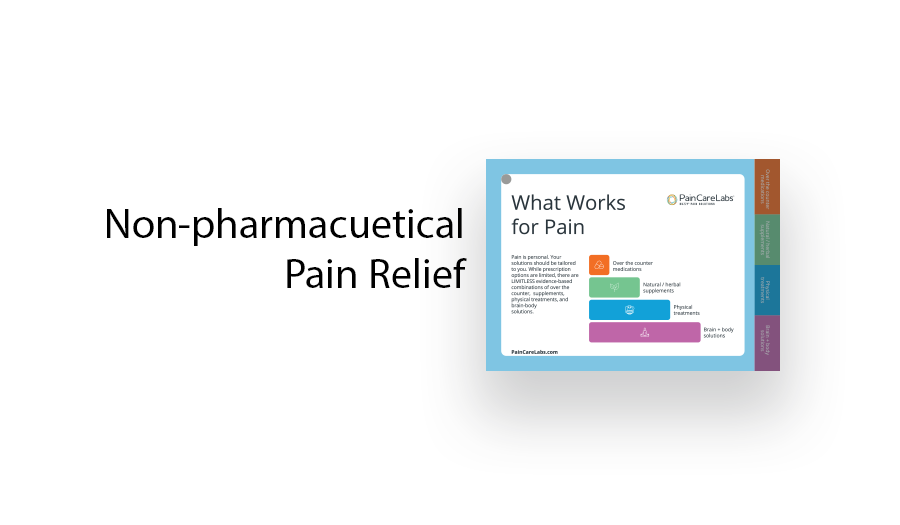Blog

Pain Management Without Drugs: A Multimodal Approach
Pain management without drugs—whether it’s termed “nonpharmacologic,” “multimodal approach,” or “nonpharmaceutical” support—is now the first step in the American Academy of Pediatrics' guidelines for responsible opioid use. But given that insurance often covers drugs while leaving out prescription devices, and our tendency to view complementary medicine as fringe, what’s a doctor to do? Effective nonpharmacologic support requires understanding pain as a survival mechanism, and managing it involves more than simply prescribing opioids.
In simple terms, nonpharmacologic and the other terms mean managing pain without medications. These strategies focus on using physical, mental, and natural techniques to help the body and mind reduce the feeling of pain. Let’s break down some of these options to show how they work.
Physical Techniques for Pain Relief
Physical methods like movement and therapy reduce pain by letting the brain know you're not in danger. Regular exercise, stretching, and physical therapy can help strengthen muscles, improve flexibility, and increase the support of muscles near the injury to reduce pain over time. Physical activity boosts the body’s natural painkillers, like endorphins, which help reduce pain sensations. Techniques like massage, acupuncture, and even gentle yoga can also interrupt pain signals by relaxing tight muscles and promoting better blood flow. These approaches not only help in the short term but can also prevent future pain by keeping the body strong and flexible.
Vibration and Mechanical Stimulation
Thermal Therapy
Heat and cold therapy are simple yet powerful ways that relieve pain in very different ways. Applying heat can relax muscles and increase blood flow to the affected area, speeding up healing and reducing the pain from holding tension. Heating pads or warm baths are great for reducing stiffness and easing chronic pain. Cold therapy, like ice packs, works in a few different ways. At the site of injury, cold reduces the creation of molecules that cause inflammation. By slowing nerve conduction, cold numbs sharp pain. This is especially helpful for injuries like sprains or strains. And when the brain feels something very cold, it tells the spine "this isn't dangerous, don't transmit so much pain noise" - a mechanism called Central Inhibition, "Descending Noxious Inhibitory Control". Alternating between heat and cold can be particularly effective, offering both relief and recovery support in a short period of time.
Mental Rewards and Pain Reduction
Our brain plays a huge role in how we experience pain. Positive mental rewards—like relaxation, pleasure, or satisfaction—can reduce pain intensity with different neurotransmitters for different types of activity. Mind-body practices such as meditation, deep breathing, or mindfulness help lower stress and anxiety, which often worsen pain. Activities that bring a sense of accomplishment, like completing a task or hobby, can also trigger the release of dopamine, a brain chemical that reduces pain. By focusing on friends and family, oxytocin helps inhibit pain. Better mental well-being helps shift the brain’s focus away from pain and onto more positive experiences.
Supplements to Support Pain Relief
Certain supplements can support the body’s natural ability to manage pain. For example, magnesium is important for muscle function and can reduce muscle cramps and spasms. Omega-3 fatty acids, found in fish oil, are known to reduce inflammation, which is a common cause of pain. Turmeric contains curcumin, a natural anti-inflammatory, and may help with joint pain. Supplements like these can enhance the body’s internal systems that fight pain, especially when combined with other non-drug treatments.
Distraction as a Pain Management Tool
Distraction is a surprisingly effective way to reduce pain. Focusing on something else—like a good book, a fun game, or a conversation with a friend—can help the brain move its attention away from the pain signals. Engaging activities can be particularly useful for short-term pain, like after an injury or surgery, but even chronic pain sufferers can benefit from keeping their minds occupied with hobbies or interests. By shifting focus, the brain’s perception of pain can be reduced, making it feel less overwhelming.
By combining physical activities, thermal therapy, mental rewards, supplements, and distraction, we can create a multimodal approach to pain relief. These techniques work together to reduce pain, improve healing, and help the body manage discomfort without relying solely on medication.